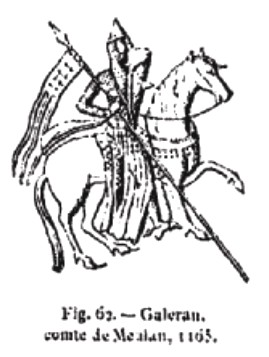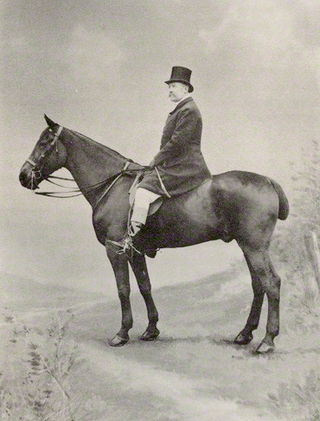
Duke of Somerset, from the county of Somerset, is a title that has been created five times in the peerage of England. It is particularly associated with two families: the Beauforts, who held the title from the creation of 1448, and the Seymours, from the creation of 1547, in whose name the title is still held. The present dukedom is unique, in that the first holder of the title created it for himself in his capacity of Lord Protector of the Kingdom of England, using a power granted in the will of his nephew King Edward VI.

Duke of Beaufort is a title in the Peerage of England. It was created by Charles II in 1682 for Henry Somerset, 3rd Marquess of Worcester, a descendant of Charles Somerset, 1st Earl of Worcester, legitimised son of Henry Beaufort, 3rd Duke of Somerset, a Lancastrian leader in the Wars of the Roses. The name Beaufort refers to a castle in Champagne, France. It is the only current dukedom to take its name from a place outside the British Isles.
The Peerage of the United Kingdom is one of the five Peerages in the United Kingdom. It comprises most peerages created in the United Kingdom of Great Britain and Ireland after the Acts of Union in 1801, when it replaced the Peerage of Great Britain. New peers continued to be created in the Peerage of Ireland until 1898

Charles Somerset, 1st Earl of Worcester, was an English nobleman and politician. He was the bastard son of Henry Beaufort, 3rd Duke of Somerset by his mistress Joan Hill.

Baron Hastings is a title that has been created three times. The first creation was in the Peerage of England in 1290, and is extant. The second creation was in the Peerage of England in 1299, and became extinct on the death of the first holder in c. 1314. The third creation was in the Peerage of England in 1461, and has been in abeyance since 1960.

Baron Wharton is a title in the Peerage of England, originally granted by letters patent to the heirs male of the 1st Baron, which was forfeited in 1729 when the last male-line heir was declared an outlaw. The Barony was erroneously revived in 1916 by writ of summons, thanks to an 1844 decision in the House of Lords based on absence of documentation. As such, the current Barony of Wharton could more accurately be listed as a new Barony, created in 1916, with the precedence of the older Barony.
Baron Darcy de Knayth is a title in the Peerage of England. It was created in 1332 for John Darcy with remainder to his heirs general, allowing daughters to inherit.

Baron Hungerford is a title in the Peerage of England. It was created on 7 January 1426 for Walter Hungerford, who was summoned to parliament, had been Member of Parliament, Speaker of the House and invested as Knight of the Order of the Garter before and was made Lord High Treasurer one year before he became a peer. The man who would later succeed as third baron was created Baron de Moleyns on 13 January 1445 by writ of summons; both titles merged when he succeeded as Baron Hungerford in 1459. The third baron was attainted and the peerage forfeit in 1461. This attainder was reversed in 1485 for the then 4th baroness of Hungerford, and so it came into the Hastings family of Earls of Huntingdon until 1789, when it came into the Rawdon(-Hastings) family of the Marquesses of Hastings until 1868 when it fell into abeyance. This abeyance was terminated three years later for a member of the Abney-Hastings family and an Earl of Loudoun. In 1920 it again fell into abeyance, which was terminated one year later for the Philipps family of the Viscounts of St Davids where it has remained since.

Earl of Worcester is a title that has been created five times in the Peerage of England. Worcester is a cathedral city in Worcestershire, England.

Marquess of Hastings was a title in the Peerage of the United Kingdom. It was created on 6 December 1816 for Francis Rawdon-Hastings, 2nd Earl of Moira.
In English law, the justices in eyre were the highest magistrates, and presided over the court of justice-seat, a triennial court held to punish offenders against the forest law and enquire into the state of the forest and its officers.
The title Baron Bergavenny was created several times in the Peerage of England and once in the Peerage of Great Britain, all but the first being baronies created by error. Abergavenny is a market town in South East Wales with a castle established by the Norman lord Hamelin de Balun c. 1087.

Henry Hugh Arthur FitzRoy Somerset, 10th Duke of Beaufort, styled Marquess of Worcester until 1924, was a peer, landowner, society figure and a great authority in the fields of horse racing and fox-hunting. He held the office of Master of the Horse for over forty years (1936–1978), the longest to hold the position. He founded the Badminton Horse Trials and was deemed "the greatest fox-hunter of the twentieth century"; his long tenure as Master of the Beaufort Hunt led to his being universally nicknamed Master and his car bore the private numberplate MFH1. In 1980 he published the authoritative book Fox-Hunting.

Captain Henry Adelbert Wellington FitzRoy Somerset, 9th Duke of Beaufort, styled the Earl of Glamorgan until 1853 and Marquess of Worcester between 1853 and 1899, was a British peer.
Lady Cathleen Blanche Lily Hudson, also known as Lady Cathleen Seyfried, was a British noble. She was the younger daughter of John Granville Cornwallis Eliot, 6th Earl of St Germans and Lady Blanche Linnie Somerset, daughter of the 9th Duke of Beaufort. She was the mother of the present Baron Herbert.

The title Baron Grey of Powis (1482–1552) was created for the great-grandson of Joan Charleton, co-heiress and 6th Lady of Powis (Powys) and her husband, Sir John Grey, 1st Earl of Tankerville (1384–1421) after the death of Joan's father, Edward Charleton, 5th Baron Cherleton (1370–1421) left the title in abeyance.

The Herbert family is an Anglo-Welsh noble family founded by William Herbert, known as "Black William", the son of William ap Thomas, founder of Raglan Castle, a follower of Edward IV of England in the Wars of the Roses. The name Herbert originated in 1461 when William was granted the title Baron Herbert of Raglan, having assumed an English-style surname in place of his Welsh patronymic, ap William.












